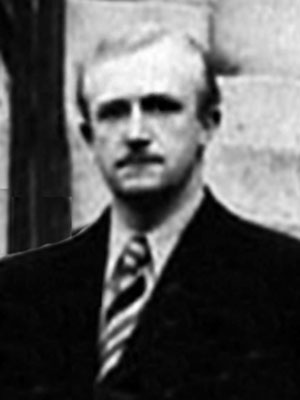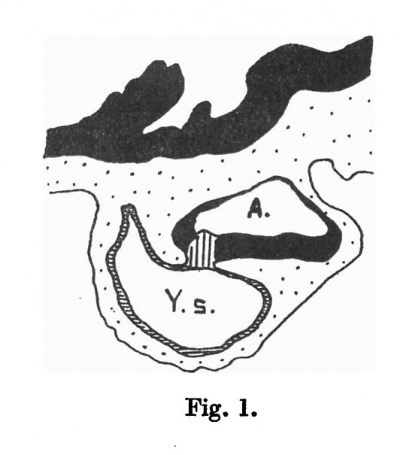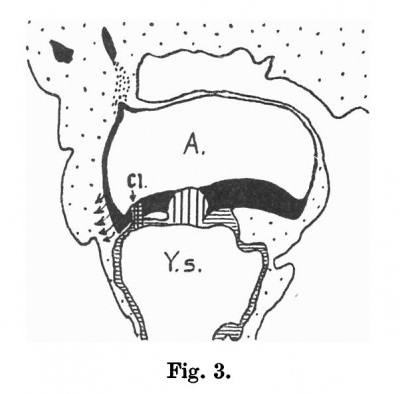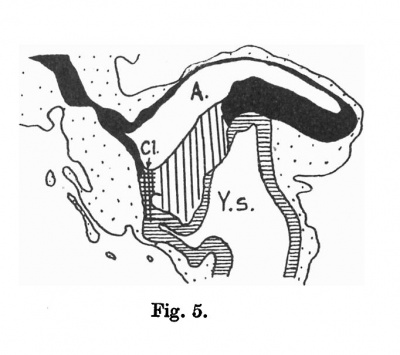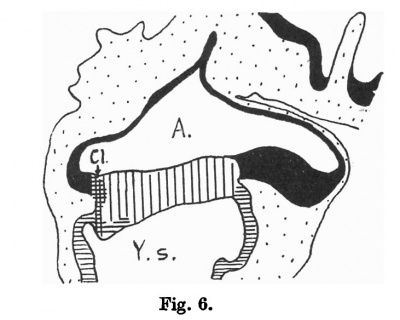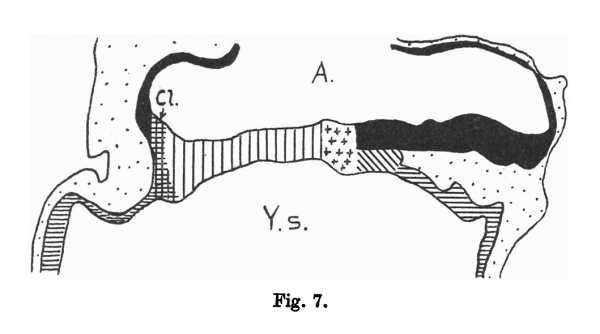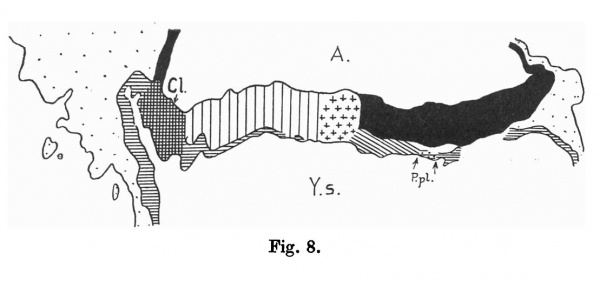Paper - The Early Development of Man, with Special Reference to the Development of the Mesoderm and Cloacal Membrane
| Embryology - 28 Apr 2024 |
|---|
| Google Translate - select your language from the list shown below (this will open a new external page) |
|
العربية | català | 中文 | 中國傳統的 | français | Deutsche | עִברִית | हिंदी | bahasa Indonesia | italiano | 日本語 | 한국어 | မြန်မာ | Pilipino | Polskie | português | ਪੰਜਾਬੀ ਦੇ | Română | русский | Español | Swahili | Svensk | ไทย | Türkçe | اردو | ייִדיש | Tiếng Việt These external translations are automated and may not be accurate. (More? About Translations) |
Florian J. The early development of man, with special reference to the development of the mesoderm and cloacal membrane. (1933) J. Anat., 67(2): 263-76. PMID 17104422
| Online Editor | ||
|---|---|---|
| This historic 1933 paper by Florian describes several early human embryos.
|
| Historic Disclaimer - information about historic embryology pages |
|---|
| Pages where the terms "Historic" (textbooks, papers, people, recommendations) appear on this site, and sections within pages where this disclaimer appears, indicate that the content and scientific understanding are specific to the time of publication. This means that while some scientific descriptions are still accurate, the terminology and interpretation of the developmental mechanisms reflect the understanding at the time of original publication and those of the preceding periods, these terms, interpretations and recommendations may not reflect our current scientific understanding. (More? Embryology History | Historic Embryology Papers) |
The Early Development of Man, with Special Reference to the Development of the Mesoderm and Cloacal Membrane
By J, Florian, M.D.
(1933)
From the Department of Anatomy and Embryology, University Colege, London, and the Department of Histology and Embryology, Masaryk University, Brno
The object of this paper is to give a short review of our present knowledge of the early stages in the development of Man, especially of the development of the mesoderm and the cloacal membrane. Although a considerable number of early human embryos have been described in the last forty years, there are still some important stages unknown and many important questions remain unsolved.There is,for instance, the question of the precise age of the known human embryos of early stages. Valuable contributions on this subject have been made by Grosser, and the reader will find all the available details in Grosser's papers of 1924 and 1927, and more recently v. Hayek (1931) and Grosser's pupil Treutler (1931) have made contributions to the solution of this difficult problem. The data thus far known, however, are insufficient to settle finally the question, in which period of the cyclic changes of the uterine mucosa the implantation of the human ovum occurs, and the length of the interval between ovulation and implantation, i.e. the duration of the migration of the human ovum from the ovary to the implantation place. Moreover we have no accurate knowledge of the details of the implantation process itself (see the different ideas described by Grosser (1924, 1927), Bryce (1924), Teacher (1925) and v. Mollendorff (1925). The lack of adequately preserved material makes it impossible to accept fully any one of these different explanations of the implantation of the human egg.
The earliest stages of the development of the human embryo so far known are already too advanced to give us an idea of the structure of the human morula and early blastocyst and of the origin of the primary mesoderm. There are several specimens described which must be considered as the earliest known human embryos. The following ova (arranged chronologically according to their description) come into consideration. Teacher-Bryce I (Bryce-Teacher, 1908; also Bryce, 1924), Kleinhans (Grosser, 1911 and 1922), SCH (v. Mollendorf, 1921a), Miller (Streeter, 1927) and the specimen described by Siegfried Mullerin1930. It is certain that all these specimens are much less developed than the embryo Peters (Peters, 1899 and Grosser, 1913) or the embryo Werner (Stieve, 1931), but it is very difficult to determine their exact sequence.Three of them are very incomplete: from the series of sections through the Kleinhans ovum (Grosser, 1922) only a single section was preserved, containing only the trophoblast and the cavity of the blastocyst cut tangentially. The other sections, including the entire embryo,were lost. Of the Miller embryo there are preserved only five sections (only four of them contain the primordia of the two vesicles of the embryo), the sequence of which was not known though Streeter has been able to arrange them in their apparent serial order. Of the S.Muller specimen only three sections are preserved, one of which is suggested by the author to represent the median section.
Of the first two specimens, one (Teacher-Bryce I) was obtained by abortion and was immersed in a mixture of blood and urine 20 hours before it was fixed in alcohol. Although the preservation of the specimen is much better than one would expect from its unfavourable history, some artificial deformation of the embryo has evidently occurred. The third of the five earliest embryos -ovum SCH v. Mdllendorff-shows such surprising conditions, so different from those one would expect on the basis ofother known embryos that ithas called forth doubts whether it is a normal ovum (see Grosser, 1924). The probability of artificial deformation is increased by the fact that the specimen is an abortive ovum.
Under such circumstances, it is really impossible to determine the developmental sequence of these five specimens: the Kleinhans ovum can hardly be discussed because of the entire absence of the embryo. The embryo SCH is somewhat doubtful because of its history and peculiar form. On the other hand, we must bear in mind that v. Mollendorff (1925) does not admit any deformation of the specimen on the ground of his own study of the sections. If he is right in this point, he is certainly justified in maintaining that the peculiar form of the embryo must not be used as a proof of the abnormality or deformation of the specimen.
The S. Muller specimen represents perhaps the youngest known stage of the development of the human embryo, but the loss of most of the sections considerably diminishes its value. Also its preservation is not perfect: the supposed primary mesoderm of the chorion is detached from the chorionic ectoderm and an extensive artificial cleft is present between them; the continuity of the chorion, adjacent to the later decidua capsularis, is interrupted by a large opening and the shrunken and detached inner contents of the blastocyst are situated in this opening. The most probable explanation of these conditions is an artificial breach of the chorionic wall and the dislocation of the inner contents of the blastocyst into this artificial opening. Such deformation can be easily explained as the result of pressure due to the mechanical damage during the treatment of the specimen or to the influence of the fixative. This explanation is supported by the great shrinkage exhibited by the specimen. On the other hand, we must call attention to the fact that if we accept v. Mollendorff's hypothesis concerning the implantation of the human egg (see fig.18,p.403,1921a and fig.21a-d,p.36,1925), such conditions as we can observe in the Muller specimen (the primordium of the mesoderm plus embryo is intercalated into the trophoblast which does not cover the former on its outer surface) would be quite normal. But, quite apart from the state of preservation of this specimen, we are not prepared to accept v. Mollendorff's hypothesis without hesitation.
The specimens Teacher-Bryce I and Miller represent nearly the same developmental stage. v.Mollendorff suggested (1921a, pp.369-70, 359,384) that the Miller ovum might belong to a much more advanced developmental stage than was supposed by Streeter, and that the section published by Miller (1913)really is at an gential one. v.Mdllendorff calls attention to the possibility of the existence of the connecting stalk in this specimen and thinks that the embryo in the Miller ovum is perhaps more advanced in itsdevelopment than that of the ovum Teacher-Bryce I, but it is very difficult to determine what was the actual form of the latter in the living specimen because of the unfavourable conditions of preservation, or the actual size and structure of the embryo of the Miller ovum because of the incomplete series of sections. Inmy opinion, the trophoblast of the Miller ovum seems to be less advanced in its differentiation than that of the Teacher-Bryce I, because the network of plasmodium in the former is distinctly less abundant than that of the latter and because of the presence of a great quantity of blood in theTeacher-BryceI specimen and the lack of blood in the trophoblast of the Miller ovum.
As was stated above, no final conclusions can be made as concerns the development of the entire embryonic primordium in these five specimens, but one fact cannot be doubted, the presence of mesoderm in stages where the primitive streak is certainly not yet present. The origin of the mesoderm in these stages must stilbe regarded as unknown because ofthe insufficiently good preservation of the specimens.
We come now to the discussion of specimens not only more advanced but much better preserved than those mentioned above. The earliest of these are the embryos Peters and Werner (Stieve, 1931). The latter was described only very briefly at the meeting of the Anatomische Gesellschaft in Breslauin 1931. Its measurements and its form show that it is certainly younger than the embryo Peters; its preservation also seems to be better than that of the latter. It is the youngest fairly well-preserved human embryo so far obtained. As I have stated above,the five earlier specimens do not admit the study of the development of the primary mesoderm because of their poor preservation. The Werner embryo is the earliest specimen where it may be suggested that at least a part of the primary mesoderm might originate from the embryonic ectoderm.
In the description of the Fetzer embryo (Fetzer-Florian, 1930, pp. 433-6) I have discussed the possibility of the existence of an area in the most caudal part of the embryonic disc where the primary mesoderm is fused with the ectoderm (fig.3). I have suggested that we might have here before us an area where primary mesoderm originates (at least in part). This area is situated close behind the primordium of the cloacal membrane. To this idea I was led by Prof. J. P. Hill's observations of a similar area in a very young embryo of Hapalejacchus (see Fetzer-Florian,1930, p.433). By the kind permission of Prof. Stieve I have had the opportunity of making a series of graphic reconstructions of transverse sections of the embryo Werner (the specimen is cut longitudinally), and I have used the area in question (where the ectoderm of the most caudal part of the embryonal shield is fused with the primary mesoderm and where, I suggest, primary mesoderm probably originates) for the determination of the median plane, and I have utilised also the primordium of the connecting, stalk though this is still very indistinct.The existence of the primitive streak in this stage can certainly be excluded.
Also in the Peters embryo a fusion of the ectoderm of the caudal part of the embryonal shield with the mesoderm was suggested by Graf v. Speed (Peters, 1899, p. 111), but the author did not give a further explanation of this condition. In 1909 Grosser (loc.cit. pp.78-9) designated this fusion of the two embryonal layers as a "wenigdeutlicher Primitivstreifen." Rossenbeck (1923), who has studied the Peters embryo very carefully and has published a series of photomicrographs of the caudal part of the embryo, expressed the following opinion: "...kdnnteman inder Tatdarandenken, dassessichhierum den morphologischen Ausdruck von Entwicklungsprozessen handelt, wie sic...als charakteristisch fur die Primitivstreifengenese beim Menschen vielleicht angenommenwerdenkdnnen"(loc.cit.p.360). But,according to him,this fusion could be due to the inundation of the mother by K-ions (the mother was poisoned with caustic potash) and for this reason he pronounced the Peters embryo as unfit for the solution of this question.
In the more advanced embryo Beneke (fig. 4), in which Strahl and Beneke (1910) have described a primitive groove and Strahl a head process, Rossenbeck called attention to the fact that in the region of the former there was a fusion not only between the ectodernm and mesoderm but also between the mesoderm and endoderm. Rossenbeek does not believe in the possibility of the existence of a primitive groove either in the Beneke embryo or in the embryo v. Herff (A-.Spec,1896) though v.Speed described it as present. According to Rossenbeck, ve. Speed was misled by an artificial deformation, which is difficult to believe. Rossenbeek suggests that the primitive groove exists first in the Matter embryo (Streeter, 1919) and he explains the fusion of the embryonal layers in the region in question in earlier stages as "Reste cines urspriinglich soliden Zusammenhangs im Embryonalzapfen," and the mesoderm originating from this region as a derivative of an originally solid " Mesoblastauskleidung " of the primitive chorionic cavity possibly present in the embryo SCH (loc. cit.p.375). Rossenbeck's opinion was accepted later by Grosser and v. Mollendorff. The latter originally described a primitive streak in the embryo OP (1921b), but under the influence of Rossenbeck's opinion explained (in 1925) the fusion of the ectoderm and endoderm in the embryos OP and WO as a primary fusion of the germ layers or as possibly the primordium of the cloacal membrane.
In a series of papers I have tried to solve the question of the significance of this fusion. The general results at which I have arrived are as follows:
In the embryos Werner and Peters the area of fusion of the ectoderm oft he caudal part ofthe embryonic shield with the primary mesoderm ismost probably the homologue of the corresponding area described by J.P. Hill in Hapalejacchus. Here at least a part of the primary mesoderm originates. How exten- sive this part is or whether the fusion of the ectoderm with the mesoderm is primary or secondary, cannot be determined because of the lack of adequately preserved material of earlier stages. The existence of this area in later stages, as I have suggested in the Fetzer embryo and as J. P. Hill has suggested from the examination of a photograph of a section of the embryo WO (see Fetzer- Florian, 1930; Hill, 1932), must remain in doubt because of the imperfect preservation of the Fetzer embryo and because v. Mbllendorff did not describe it in the embryos OP and WO.
In the embryo OP (fig.1), the first primordium of the primitive streak is to be found in the fusion of the ectoderm with the endoderm near the end of the embryonic shield. Nothing is known about the formation of the primary mesoderm in this specimen, as was just stated above. v.Mollendorff has described an area behind the embryonic shield (in the amnion according to the author) where the limits between the ectoderm and mesoderm are indistinct and the ectoderm cells are in process of dissolution ,but this area has probably nothing to do with the formation ofthe primary mesoderm, although it cannot be, in my opinion ,quite excluded; its significance will be discussed later on p.274.
Similar conditions with regard to the primordium of the primitive streak can be observed also in the embryo WO (fig.2) and Fetzer (fig.3).Butalready in the former I believe the first indications of the formation of the cloacal membrane can be found in the thickened endoderm area in the dorsal wall of the yolk sac underneath the caudal margin of the ectoderm of the embryonal shield, which v. Mollendorff has described as the primordium of the allantois (fig.2, CO.?). The two embryonal layers are not yet fused. In the Fetzer embryo (Fetzer and Florian, 1930), there is a distinct fusion of the ectoderm and endoderm in this region, accordingly a further step in the formation of the cloacal membrane. This fusion is situated underneath the caudal margin of the shield ectoderm and is separated from the primordium of the primitive streak by an area in which the embryonal layers are quite distinct from each other. The primordium of the primitive streak, accordingly, does not extend up to the cloacal membrane. The primitive streak and the cloacal membrane are separated also in the Beneke embryo (Florian and Beneke,1930-1), but in this specimen (fig. 4) the development of the primitive streak is much more advanced:it no longer possesses the form of a node (as is the case in the embryo OP, WO and Fetzer), but now forms a short streak, and the formation of mesoderm is here very distinct.
Figs. 1-8. Median sections through eight young human embryos
The cranial end on the right, the caudal end on the left:x 100. Ectoderm black; endoderm lined horizontally,head process lined obliquely, primitive streak and secondary mesoderm lined vertically. Primary mesoderm dotted. l. = cloacal membrane; lined vertically and horizontally. Hensen's knot marked by crosses. P.pl.= prochordalplate; lined horizontally and dotted. A= amniotic cavity. Y.S.= yolk- sac cavity.
| Fig. 5. Embryo Bi(ttman)I. (Based on fig.1, Florian,1927; somewhat altered.)
It is very difficult to determine whether the primitive streak has reached the cloacal membrane in the embryo T.F. (Florian, 1928) (fig. 6) because of the thickness of the sections and the imperfect preservation of the specimen. In the embryo Bi I (Florian, 1927) (fig. 5), which represents a stage only slightly more advanced than the embryo Beneke and certainly younger than embryo T.F., the primitive streak does not reach the very distinct primordium of the cloacal membrane, but the distance between the two is much smaller than in the embryo Beneke.
Grosser described a new young human embryo at the meeting of the Anatomische Gesellschaft in Breslau (1931 b), which belongs to a stage between the embryos T.F.andHugo. In this specimen there is a distinct fusion of ectoderm and endoderm caudally to the primitive streak and separated from thel atter by an area where the columnar cells of the ectoderm of the embryonal shield are distinctly delimited from the underlying mesoderm. Inmy opinion, this fusion of the ectoderm of the embryonal shield with the endoderm represents the primordium of the cloacal membrane. There is nothing strange in the separation of the primitive streak from the cloacal membrane, as this is the case in the next earlier specimens. Grosser suggested that the primordium of the cloacal membrane is situated close to the caudal end of the primitive streak in this specimen, but he admits that no fusion of the ectoderm and endoderm exists in this place. The fusion which I interpret as a primordium of the cloacal membrane in this embryo would be, in Grosser's opinion, a fusion of the amniotic ectoderm-n with the endoderm (of the yolk sac), therefore a structure which would be comparable only with the "canalis amnio-allantoideus." Tim existence in Man of a structure (fusion of the ectoderm of the amnion with the allantoic endodermn) comparable with the so-called "canalis amnio- allantoideus" was first suggested by Ingalls (1918).
In later stages the primitive streak reaches the cloacal membrane (this is certainly the case in the embryo Bi 24 (fig. 8) and probably also in the embryo Hugo) and both structures become continuous. (In the Hugo embryo (fig.7) the primordium of the cloacal membrane was not described by Stieve in the original paper, but by the kind permission of Prof. Stieve I have been able to study the sections of this embryo and have seen the cloacal membrane; see Florian, 1928, p. 545.)
In the stage of the embryo Bi 24, the cloacal membrane first exhibits the form of an actual membrane, whilst in the earlier stages it is represented by a cell cord varying in length and connecting the ectoderm with the endoderm. In all well-preserved embryos belonging to more advanced stages the cloacal membrane is distinctly present (embryos Schd, Waldeyer, 1929; Wa 17, Grosser,1931a; Kl13, Grosser,1913; Ho, Fahrenholz,1927; Dobbin, J.P. Hill and Florian,1931a and b; Peh.i Hochsteter, Rossenbeck, 1923, etc.).
The structure interpreted by me as the primordium of the primitive streak in the embryos OP, WO, Fetzer and Beneke, as stated above, has the form of a node. The Beneke embryo is the earliest specimen in which it becomes distinctly elongated (towards the caudal end (of the embryonal shield) and so deserves the name "streak." In all more advanced specimens (beginning with the embryo Bi I) its elongated form becomes still more distinct.
Just after the formation of the mesoderm has started in the primitive streak (embryos Beneke and Bi I),probably mostly by cell migration from the ectoderm, the mesodermal cells gather underneath the caudal extremity of the primitive streak; in the embryo Beneke, we (Florian and Beneke, 1930-1) could trace the secondary mesoderm behind the caudal end of the primitive streak around the cloacal membrane into the connecting stalk. This was made possible by the fact that the secondary mesoderm in this early stage of its development was formed by very closely arranged cels, whilst the primary mesoderm possessed more the character of mesenchyme, its cells being separated from each other by more or less enlarged intercellular spaces. This observation is of importance, since it shows that the secondary or primitive streak mesoderm is not entirely used up in the formation of the embryonic body but certainly forms also a part of the connecting stalk. There is no evidence, however, that the secondary mesoderm in Man could be traced up into the chorionic membrane.
The above-mentioned accumulation of the mesoderm cells underneath and behind the caudal extremity of the primitive streak leads to the formation of a node in this place, the "end-node" (Endknoten, Florian, 1928), observed already by Stieve (1926) in the embryo Hugo and designated by this author as "Siclhelknoten." This structure is to be regarded as the product of the primitive streak (see also Stieve, 1926,1) .352). It is present only in the early stages of the development of the primitive streak and very soon becomes indistinct, the cells of which it is composed assuming thec haracter of mesenchiyme. So we can understand why it was not observed in more advanced embryos than the "Hugo." In the Bi24 the end-node is still recognizable.
If we recapitulate the chief observations stated above, we may distinguish three different areas in the caudal half of the embryonal shield in its median axis: (1) the most caudal area, differentiated in the earliest stages (embryos Werner, Peters and perhaps OP, WO and Fetzer), in which at least apart of the primary mesoderm is formed by cell emigration from the ectoderm of the most caudal part of the embryonal shield or close behind its caudal margin. (2) The intermediate area, i.e. the cloacal membrane, separated in the early stages (embryos Fetzer, Bi I, T.F., Grosser, 1931b), from the primordium of (3) the most cranial area, i.e. the primitive streak, which appears just before the development of the cloacal membrane (embryos OP and WO). It is not possible to determine whether the areas (1) and (2) are separated from each other or not because of the lack of adequate material. If we realise that the cloacal membrane and the primitive streak represent parts of the blastopore in lower vertebrates, we must accept the view that the homologue of the blastopore in Man originates in two separated areas which grow together only during later development. This fact has perhaps caused the difficulties in interpretation of the structure which I regard as cloacal membrane. If we remember that the development of the caudal part of the human embryo is distinctly accelerated in comparison with the cranial part (Florian, 1930a), we can understand the extremely early appearance of the cloacal membrane. The precocious development of the allantois and of the umbilical stalk is another proof of this interpretation. So also is the fact to which G.Politzer has called my attention, viz. that the caudal part of the human embryo becomes elevated above the level of the embryonal shield simultaneously with the cranial end, whilst in lower Mammals the elevation of the cranial end precedes that of the caudal end.We may accordingly regard it as a characteristic of early human development that the differentiation of the caudal part of the embryonal shield is accelerated, and that in the early stages certain areas of the embryonal shield (e.g. the region of the cloacal membrane) attain a development which in lower Mammals is reached only in much more advanced stages. It is worthy of consideration whether we may interpret also the area (1) as a part ofthe blastopore, but there are not enough human embryos ofthis stage known to solve this problem finally. This area is certainly in no connection with the earliest primordium of the primitive streak, but, on the other hand, it is in close proximity to the primordium of the cloacal membrane which isthe homologue of the ventral lip of the blastopore.
There seems to be a distinct difference between the development of the primary mesoderm in Man in the region in question and the development of the connecting stalk and the exocoelom in lower Primates (Tarsius). In Tarsius there is a structure developed which may be compared with the connecting stalk in Man (Hubrecht, 1902; Hill, 1932), and the exocoelom appears in very early stages as in Man and much earlier than in other Mammals. But in Tarsius these two structures originate certainly in a formation which becomes a typical primitive streak (as Hill (1932) has shown; Hubrecht (1902) has designated as "ventral mesoderm" what other authors call primitive streak mesoderm), whilst in Man the site of origin of the primary mesodermis situated behind the primitive streak, if my interpretation of the conditions in the embryo Fetzer is right.
Hill's observation on an early Hapale embryo (Hill,1932 )represents a very important contribution to our knowledge of the origin of the so-called primary mesoderm. There is an extreme similarity between this specimen (loc. cit. Plate9,fig.56) and the Werner embryo. According to Hill,wehaveinthe Hapale not to do with a typical primitive streak but with a structure which precedes the latter; with this explanation I am in complete agreement. The same is, in my opinion, the case in the Werner embryo. As Hill could study only one specimen of Hapale, it is not possible to determine whether the fate of the region in question in later stages is the same in Hapale as it is in Man.
We now pass to the discussion of one fact which makes the study of the development of the mesoderm and the distinction of the primary mesoderm from the secondary mesoderm very dificult. In very many places the limits between the mesoderm and the yolk-sac endoderm are so indistinct that the delimitation of these two layers is most difficult or quite impossible. There is evidence of fusion of the endoderm with the mesoderm of the primitive streak (at least in the median line), so that the former does not represent a distinct and independent layer (see also Rossenbeck's statements concerning the Beneke embryo mentioned in the paper of 1923 on p.365). So it is in the earliest stages of the primitive streak before a distinct mesoderm formation takes place (see the primitive streak primordiumin the embryos OP,WO and Fetzer) and during a certain period after mesoderm formation has started. I have seen this fusion of the endoderm and mesoderm in the embryos Beneke, Bi I, T.F. and Bi 24. Stieve has mentioned it in the embryo Hugo (1926, p. 355). The relations are similar to those between the endoderm and what Hill and Florian (1931b) regard as mesoderm of the primitive streak accompanying the head process on both sides and cranially coming into connection with the prochordal plate. Stieve interprets this fusion between the mesoderm and endoderm as a proof of mesoderm production by endoderm and calls this mesoderm " Dotter- sackmesoderm." The fusion can also be observed in many places far from the medianline. Fahrenholz has described (1927) a semicircular area in front of the head process in the embryo Ho, where the mesoderm is present and fused with the endoderm. Whether the "Dottersack mesoderm" really is the result of mesoderm formation from endoderm, cannot, in my opinion, be determined in sections, as there is still the possibility of a secondary fusion of the two embryonal layers.
The embryonal layers are in no place completely separated from each other by empty clefts, but are connected by means of cytodesmata. Intheearliest stages they are most distinct between the ectoderm and mesoderm of the amnion and the endoderm and mesoderm of the yolk sac. The ectoderm of the embryonal shield (apart from the region of the primitive streak, cloacal membrane and the region of the formation of the primary mesoderm) is in early stages very well delimited on its under surface, often by a very distinct basal membrane (visible even in badly preserved specimens). The prolongations of the underlying mesoderm cells can be traced to this membrane. In later stages the celsofthe ectoderm ofthe embryonal shield become connected with the underlying mesoderm cels by means of distinct cytodesmata and the basal membrane is no longer distinguishable. (For details, see Studnilka-Florian, 1928, and Studnicka, 1929; the latter has studied the cytodesmata between the embryonal layers in a large series of human embryos.)
In the shape of the yolk-sac and in the form of its endoderm great differences are to be observed even in very close stages (cf. the embryos Beneke and Bi I, figs. 4 and 5, belonging to almost the same developmental stage). The yolk-sac process, originally described by Strahl and Beneke (1910), has been observed (in very varying form) in many other specimens. There is as yet no consensus of opinion amongst authors as to its development. The development of the yolk-sac endoderm itself is quite unknown. We donotknowwhetherthe yolk-sac arises as a closed vesicle or as a solid mass of endoderm, though Hill (1932) has brought forward evidence that in Selenka's Keim S of Nasalis larvatus the yolk-sac arises by the vacuolisation of an originally solid mass of endoderm. On the other hand, Stieve (1931) has advocated the view that the yolk-sac in Man is formed by the spreading of an endodermal layer as in lower Mammals.
In regard to the yolk-sac endoderm, I desire to call attention to one fact: the endoderm underneath the centre of the embryonal shield (in front of the primordium of the primitive streak) in the embryos Fetzer (Fetzer and Florian, 1930), Schlagenhaufer-Verocay (1916, p. 164) and Bi I is composed of much enlarged,vesicularcels. In the Beneke embryo (Florian and Beneke,1930-1), there isalso such an area of vesicular cels, but itisfar in front of the cranial end of the primitive streak. The significance of this area is not yet determined (for further details see Hill and Florian, 1931 b). Finally we may mention the presence of cells in the most caudal part of the yolk-sac endodermn in the embryo Bi 24, which seem to be identical with those which Politzer has designated as primary gonocytes (Florian,1931). If these cells are really primary gonocytes, the embryo Bi 24 would be the earliest human embryo, in which they have been recognized, as in the next younger embryo (Hugo) they are not present.
v. Mdllendorff called attention (1921b) to the presence of the "cell debris" (Zelltrimmner) situated in the amniotic cavity of young human embryos, and showed that they originate in a "Zerfallende Epithelwucherung" of the amnioticectoderm. In his opinion the anmiotic cavity (originating by dehiscence) increases in size at the cost of this "Epithelwucherung." I have tried to show (1930 a) that the stalk ectoderm (i.e. the continuation of the ectoderm of the amnion in that region where it covers the mesoderm of the connecting stalk and which corresponds in very young stages with the "Epithelwucherung" described by v. M6llendorff) invades the mesoderm of the connecting stalk also in much more advanced stages (for instance in the embryo Bi XI with ten paired somites), and that it can eventually separate off pieces of stalk mesoderm which come to lie free in the amniotic cavity where they are finally dissolved. In the connecting stalk itself, I have distinguished two parts: the amnio-embryonal stalk and the umbilical stalk. In the same paper and partly in a paper published by Volker and myself (1929), it was suggested that the structure which was designated by other authors as "allantois" in early human embryos, really represents also a part of the hind-gut and should be called, therefore, " allanto-enteric diverticulum."
In this brief review I have dealt chiefly with the early development of the axial structures of the embryonal shield. For the accurate study of these structures the most important condition is the determination of the median plane,which is only possible after the determination of the sectional plane. I have had the opportunity to determine the sectional plane in the embryos Fetzer (Fetzer and Florian, 1930), Beneke (Florian and Beneke, 1930-1), Bi I (Florian, 1927), T.F. (Florian, 1928 and 1930b), Hugo (Florian, 1930b) and Bi24. I have also tried to determine the sectional plane in the embryos OP and WO (Florian,1930b), but my estimation could be only very approximate, because I have had no opportunity to study the sections and the original description of these embryos does not contain sufficient figures to permit a graphic reconstruction, such as I could make in the case of the embryo "Hugo." The specimens referred to form a continuous series and make possible a detailed study of the early development of the axial structures.
It is not necessary to follow here the later stages in which the head process and the prochordal plate are established, since Hill and Florian (1931 b) have provided a review of the development of human embryos in these stages, with references to the literature.
In conclusion, I desire to thank Prof. J. P. Hill for his great interest in my work, for his help and for reading the manuscript of this paper.
References
Bryce TH. Observations on the early development of the human embryo. (1924) Trans. Roy. Soc. Edinburgh, 53: 533-567.
Bryce TH. and Teacher JH. Contributions To The Study Of The Early Development And Imbedding Of The Human Ovum 1. An Early Ovum Imbedded In The Decidua. (1908) James Maclehose and Sons. Glasgow.
AHRENHOLZ,C. (1927). Zeitschr.f.mikr.-anat.Forsch.Bd.viii.
FETZER, M. (1910). Anat.Anz.Bd.xxxvii,Erg.-Heft. (Verh.d.anat.Ges.,Brissel.)
FETZER, M. and FLORIAN, J. (1930). Zeitschr. f. mikr.-anat. Forsch. Bd. xxi, Heft 1-3.
FLORIAN,J.(1927). Anat. Anz. Bd. LXIII, Erg. - Heft.(Verh.d.anat.Ges.,Kiel.)
- (1928). Zeitschr. f. mikr. - anat. Forsch. Bd. XI, Heft3-4.
Florian J. The formation of the connecting stalk and the extension of the amniotic cavity towards the tissue of the connecting stalk in young human embryos. (1930) J. Anat., 64: 454-476.
- (1930b). Anat. Anz. Bd. LXXI.
- (1931). Anat. Anz. Bd. LXXII,Erg. - Heft. (Verh. d. anat. Ges., Breslau.)
FLORIAN, J. and BENEKE, R. (1930-1). Anat. Anz. Bd. LXXI, Errg. - Heft. (Verh.d.anat. Ges., Amsterdam.)
FLORIAN, J. and VOLKER, 0. (1929). Zeitschr. f. mikr.- anat. Forsch. Bd. XVI,Heft1-2.
GROSSER, 0. (1909). Vergleichende Anatomie und Entwicklungsgeschichte der Eihdate und der Placenta. Braumiiller,Wien.
- (1911). Anat. Anz. Bd.XXXviII,Erg. - Heft. (Verh.d.anat.Ges., Leipzig.)
- (1913). Anat. Hefte, Bd. XLVII.
- (1922). Zeitschr.f.d.ges. Anat. Abt. 1, Bd. LXVI.
- (1924). Erg.d. Anat.u. Entw. Bd.xxv.
- (1927). "Friihentwicklung, Eihautbildung und Placentation des Menschen und der Siiugetiere." Deutsch. Frauenheilkunde, Bd. v.
- (1931a). Zeitschr.f.d.ges.Anat.Abt.1, Bd.XCIV.
- (1931b). Anat. Anz. Bd. LXXII, Erg. - Heft. (Verh. d. anat. Ges., Breslau.)
v. HAYEK, HEINR. (1931). Anat. Anz. Bd. LXXI.
HILL,J.P.(1932). "CroonianLecture." Phil.Trans.R.S.,SeriesB,vol.CCXXI.
HILL,J.P.andFLORIAN,J.(1931a). J.Anat.vol.LXV,pt.2. - (1931b)."Ayounghumanembryo(embryoDobbin)withhead-processandpiochordal plate." Phil.Trans.R.Soc.London,ser.B,vol.CCXIX.
HUBRECHT,A.A.W.(1902). Verh.Koningl.Akad.Amsterdam,sectie2,deelVI,No.6.
INGALLS,N.W.(1918). "Ahumanembryobeforetheappearanceofthemyotomes." (arn.Contr.
to Embryol. vol. vii, No. 23. MILLER,J.W.(1913)."CorpusluteumundSchwangerschaft. Dasjiingsteoperativerhaltene
menschlicheEi." Berlin.klin.WFochenschr.
v. MSLLENDORFF, W. (1921a). Zeitschr.f. d. ges.Anat. Abt. 1, Bd. LxII. (1921b). Zeitschr. f. d. ges. Anat. Abt. 1, Bd. LXII.
(1925). Zeitschr.f.d.ges.Anat. Abt.Bd.LXXVI.
MiULLER,SIEGFRIED.(1930). Zeitschr.f.mikr.-anat.Forsch.Bd.xx.
PETERS,H.(1899). Uberdie Einbettungdesmenschlichen Eiesunddasfrilhestebisherbekannte
menschlichePlacentationsstadium. Leipzig-Wien.
ROSSENBECK, H. (1923). Zeitschr. f. d. ges. Anat. Abt. 1, Bd. LXVI.
SCOLAGENHAUFER and VEROCAY (1916). Arch. f. Gyn. Bd. cv.
SPEE,F.GRAFV.(1896). "Neue Beobachtungenubersehrfruhe Entwicklungsstufendes menschlichen Eies. Arch.f.Anat.u.Physiol.
STIEVE, H. (1926). Zeitschr. f. mikr.-anat. Forsch. Bd. vIa.
- (1931).Anat.Anz.Bd.LXXII,Erg.-Heft.(Ver.d.anat.Ges.,Breslau.)
STRAHL, H. and BENEKE, R. (1910). Ein junger menschlicher Embryo. Wiesbaden.
STREETER, G. L. (1919). "A human embryo (Mateer) of the presomite period." Carm. Contr. to Embryol. vol. IX.
(1927). "The Miller ovum-the youngest normal human embryo thus far known. Carn. Contr. to Embryol. No. XCII.
STUDNI6KA, F. K. (1929). Zeitschr. f. mikr.-anat. Forsch. Bd. XVIII, Heft 3-4.
STUDNIC'A, F. K. and FLORIAN, J. (1928). "Les cytodesmes et le mesostroma chez quelques jeunesembryonshumains." Comp.R.del'Assoc.desAnat.239meR~union,Prague.
TEACHER, J. H. (1925). Zeitschr. f. d. ges. Anat. Abt. 1, Bd. LXXVI.
TREUTLER, K. (1931). Anat. Anz. Bd. LXXI.
WALDEYER, A.(1929). Zeitschr.f.d.ges.Anat.Abt.1,Bd.xc.
Reference
Florian J. The early development of man, with special reference to the development of the mesoderm and cloacal membrane. (1933) J. Anat., 67(2): 263-76. PMID 17104422
Cite this page: Hill, M.A. (2024, April 28) Embryology Paper - The Early Development of Man, with Special Reference to the Development of the Mesoderm and Cloacal Membrane. Retrieved from https://embryology.med.unsw.edu.au/embryology/index.php/Paper_-_The_Early_Development_of_Man,_with_Special_Reference_to_the_Development_of_the_Mesoderm_and_Cloacal_Membrane
- © Dr Mark Hill 2024, UNSW Embryology ISBN: 978 0 7334 2609 4 - UNSW CRICOS Provider Code No. 00098G


